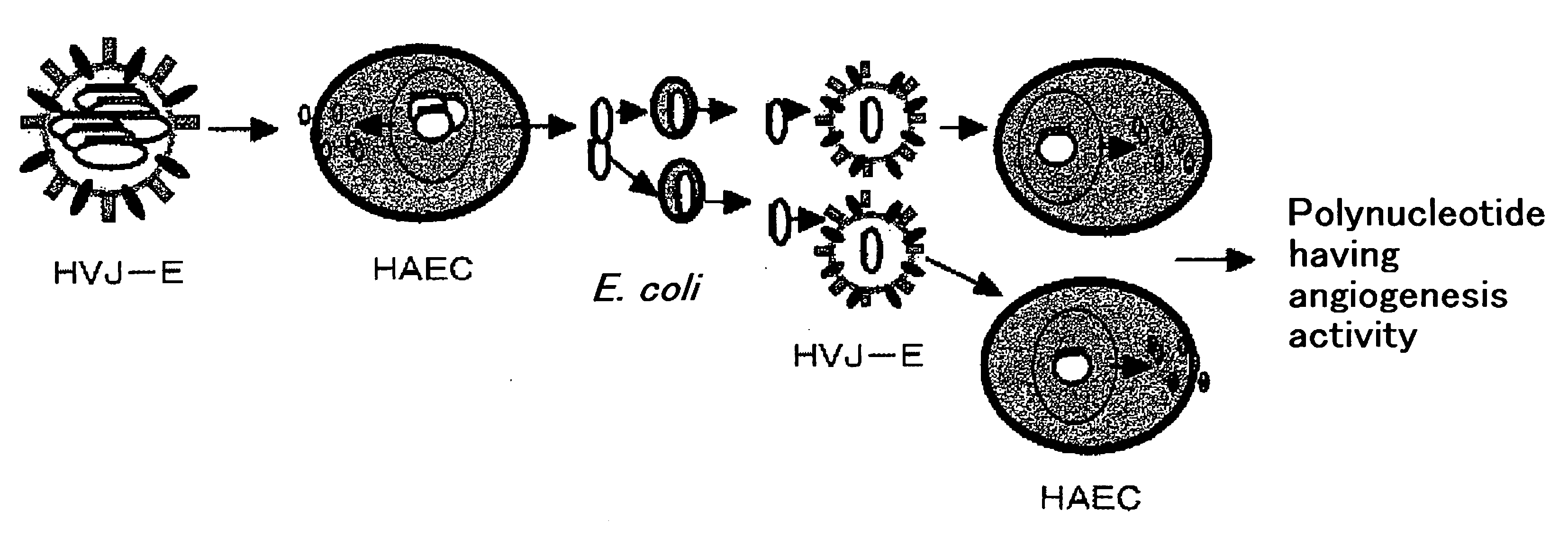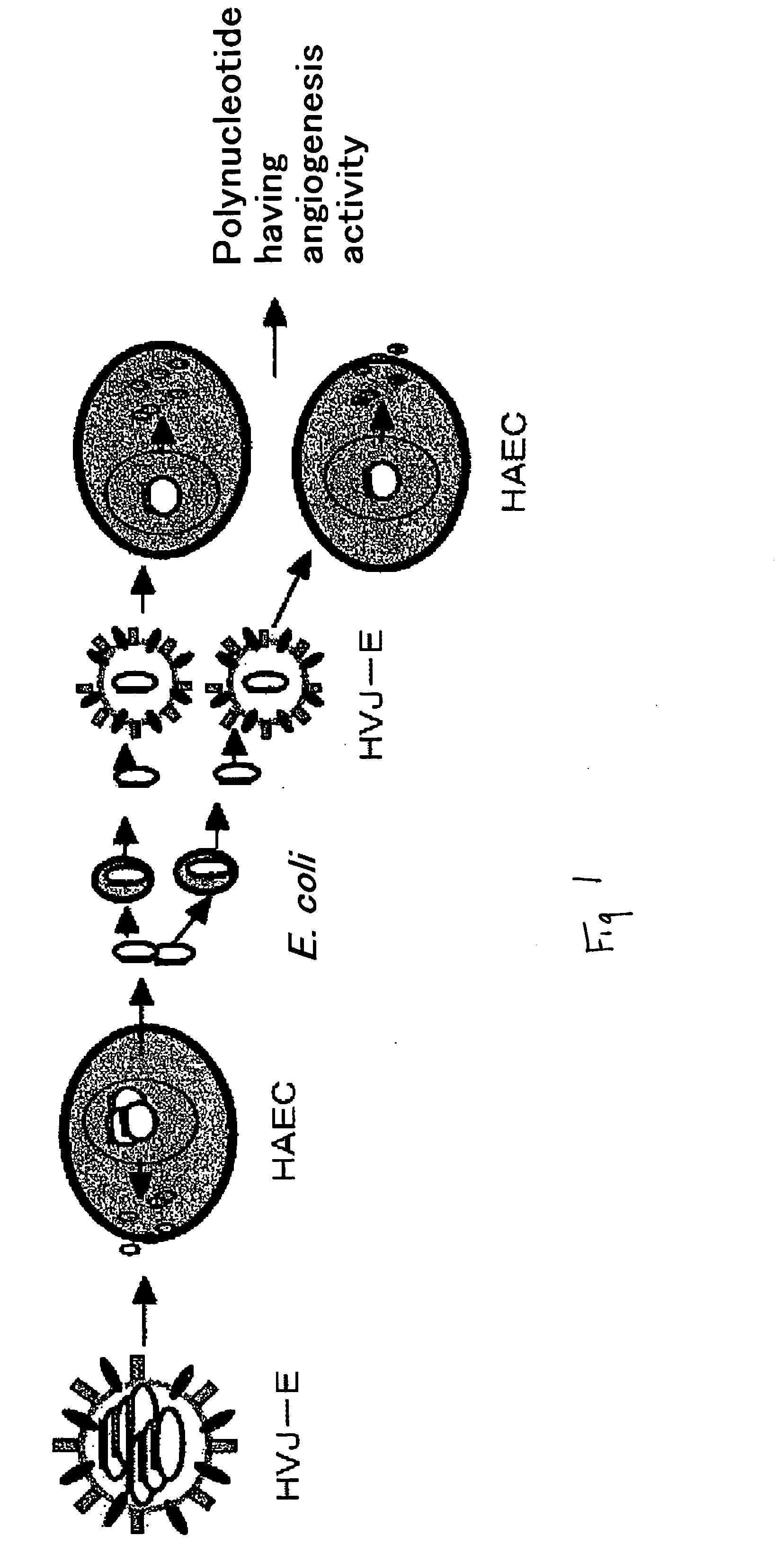Gene Promoting Vascular Endothelial Cell Growth
a technology of endothelial cells and genes, which is applied in the direction of depsipeptides, peptide/protein ingredients, viruses, etc., can solve the problems of disadvantageous ischemia of extremities, inability to treat vegf, and the majority of patients to be treated by surgery or transdermal surgery. promote transcription and promote transcription
- Summary
- Abstract
- Description
- Claims
- Application Information
AI Technical Summary
Benefits of technology
Problems solved by technology
Method used
Image
Examples
example 1
Preparation and Use of a Gene-Transfer Vector Having an Exogenous Gene Encapsulated in a Component Containing a Virus Envelope-Derived Protein
(Preparation of Virus)
[0261] HVJ, Z strain was purified by differential centrifugation as previously described, above (Kaneda, Cell Biology: A Laboratory Handbook, J. E. Celis (Ed.), Academic Press, Orlando, Fla., vol. 3, pp. 50-57 (1994)). The purified HVJ was resuspended in a buffered saline solution (BSS: 137 mM NaCl, 5.4 mM KCl, 10mM Tris-HCl, pH 7.5) and its virus titer determined by measuring absorbance at 540 nm. The optical density at 540 nm corresponds to 15,000 hemagglutinating unit (HAU) and is correlated with fusion activity.
(Preparation of a Gene-Transfer Vector)
[0262] A lipid mixture of 3.56 mg phosphatidylcholine and 0.44 mg cholesterol was dissolved in chloroform, and this lipid solution was evaporated in a rotary evaporator (Uchida et al., J. Cell. Biol. 80:10-20 (1979)). The dried lipid mixture was dissolved completely ...
example 2
Preparation and Use of an Inactivated HVJ Envelope Vector Utilizing a Detergent
(1: Growth of HVJ)
[0265] In general, HVJ grown by inoculating a fertilized chicken egg with the seed virus may be used. However, HVJ grown by utilizing cultured cells (e.g., simian or human), or a persistent infection system (i.e., a culture solution to which a hydrolase such as trypsin is added to cultured tissue), or HVJ grown by infecting cultured cells with cloned virus genome to cause persistent infection, are applicable.
[0266] In the present example, the growth of HVJ was carried out as follows.
[0267] HVJ seed virus was grown by utilizing a SPF (Specific Pathogen Free) fertilized egg. The isolated and purified HVJ (Z species) was dispensed into a tube for storing cells, and stored in liquid nitrogen with 10% DMSO added thereto. Thus, HVJ was prepared.
[0268] Chicken eggs immediately after fertilization were obtained, and placed in an incubator (SHOWA-FURANKI P-03 type; capable of accommodating ...
example 3
Isolation and Analysis of Gene Clone p3743 Encoding a Vascular Endothelial Growth Factor From a Human Heart cDNA Library
[0292] Using the present invention, the gene of interest having desired functional properties can be separated. One embodiment of the isolation methods used is schematically shown in FIG. 1.
[0293] By actually using the gene-transfer vector prepared in Example 2 in this specification, the gene encoding the vascular endothelial growth factor was isolated. As the method of isolating the gene illustrated in the Examples, it is possible to use not only the gene-transfer vector prepared in Example 2 in this specification but also any “virus envelope vector” and “liposome vector”.
[0294] A human heart cDNA library (a plasmid having human heart-derived cDNA ligated to plasmid pSPORT having a CMV promoter; GIBCO BRL) was introduced into E. coli DH12S, and the plasmid prepared from the E. coli. 200 μg of the plasmid was encapsulated in 10000 HAU of the HVJ-E gene-transfer ...
PUM
 Login to View More
Login to View More Abstract
Description
Claims
Application Information
 Login to View More
Login to View More - R&D
- Intellectual Property
- Life Sciences
- Materials
- Tech Scout
- Unparalleled Data Quality
- Higher Quality Content
- 60% Fewer Hallucinations
Browse by: Latest US Patents, China's latest patents, Technical Efficacy Thesaurus, Application Domain, Technology Topic, Popular Technical Reports.
© 2025 PatSnap. All rights reserved.Legal|Privacy policy|Modern Slavery Act Transparency Statement|Sitemap|About US| Contact US: help@patsnap.com



